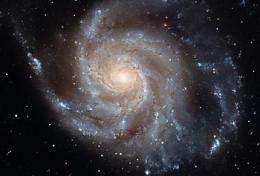Astrophysicist set to launch rocket experiment: Instrument will observe spiral galaxy near Big Dipper's handle

Astrophysicist Timothy Cook loves to build things, particularly small scientific satellites and instruments, putting them on a sounding rocket and then shooting them into space.
"How can one not find space experiments exciting?" asks Cook. "I'm hooked on all those things and I pretty much always have been. I'm fortunate to have been surrounded all my life by supportive people, but this is the sort of thing that's so cool you just do it regardless of what people think."
Cook spent the past two decades conducting experiments at Boston University. In January, he joined UMass Lowell's Department of Physics and Applied Physics as an assistant professor, where he will continue to pursue his passion.
"I don't actually build the rocket, just the payload," he notes. "The largest vehicle I've flown something on was a Pegasus rocket, which is launched from a modified L-1011 aircraft over open ocean to deliver a satellite into low-Earth orbit."
In the pre-dawn hours of Nov. 10, Cook and his research team will be at the Army's White Sands Missile Range in New Mexico, ready to launch a NASA-funded science experiment, called IMAGER, which has been five years in the making. They will use a Black Brant IX, an 18-foot-long two-stage sounding rocket capable of carrying up to 1,200 pounds of payload into suborbital flight.
"The success rate for sounding rockets is 80 to 90 percent, which sounds pretty good until you realize that it means a 10 to 20 percent failure rate," says Cook, who is the principal investigator for the NASA project. "Launch gets to be pretty nerve-wracking!"
Observing the Pinwheel Galaxy in Ultraviolet
The IMAGER's observing target is the distant spiral galaxy M101—also known as NGC 5457 or the "Pinwheel Galaxy"—located about 25 million light-years away in the constellation Ursa Major, near the Big Dipper's handle.
"Our primary goal is to take images of M101 at different ultraviolet wavelengths," explains Cook. "We're trying to find out more about dust in M101—that's right, dust. It turns out that galaxies are pretty dusty and the dust is pretty important. It blocks a lot of the light from leaving, or even moving around in, the galaxy. Dust absorbs ultraviolet light particularly well, so with our UV instrument we're particularly sensitive to its effects."
The team is looking to find out if the differences in dust absorption are due to the formation or destruction of the dust. Determining how dust varies from M101's core to its rim will help in understanding the evolutionary history of galaxies.
"Astronomy does generate practical spinoffs, but at its heart, at this point in history, it is more inspirational that practical," notes Cook. "Astronomy is more about finding our place in the universe, learning about the stunning, awe-inspiringly cool world that we live in."
Cook's team includes co-investigators Supriya Chakrabarti, who joined UMass Lowell's physics faculty in September, and Karl Gordon of the Space Telescope Science Institute in Baltimore.
He adds: "At this point our field operations are the responsibility of three people: Brian Hicks, a UMass Lowell post-doctoral researcher who just graduated from Boston University after launching Supriya's last sounding rocket; Meredith Danowski, a BU graduate student who really is the brains of the operation, and Jason Martel, a mechanical engineer with our group who just moved to UMass Lowell."
Provided by NASA





















